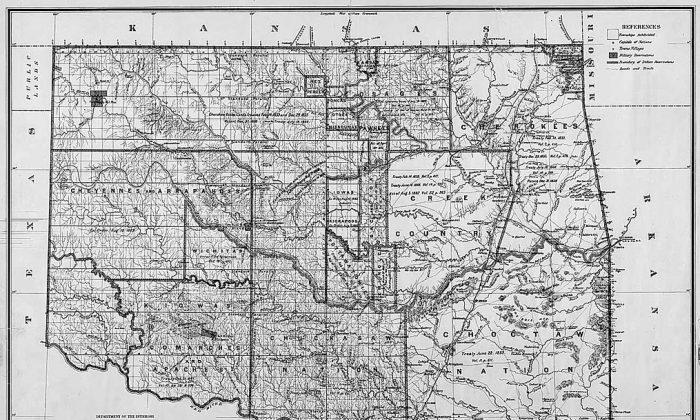Oklahoma and Texas—“Red River Rivals” on the college football field—have taken their rivalry to the U.S. Supreme Court, where the two states are squaring off over river rights. The water in dispute is in Oklahoma territory, but Texans argue that the law guarantees them a quarter of the resources.
Texas’s Tarrant County has been coveting a Red River tributary just over the Oklahoma border for over a decade. This wealthy and growing region of North Texas, home to Arlington and Fort Worth, offered to buy Oklahoma’s water in 2001. When Oklahoma responded with a moratorium on all out of state water sales, Texas sued.
The Tarrant Regional Water District (TRWD) has lost every case thus far, but the county is encouraged that the Supreme Court might finally turn in its favor. TRWD has the backing of U.S. Solicitor General Donald Verrilli who wrote a brief late last year urging the high court to reconsider the case.
According to Verrilli, previous court decisions have “great practical consequences” on the “rightful share of water” in a major urban area.
Since more than 18 major U.S. metropolitan areas depend on interstate water agreements, a high court win for Oklahoma could encourage other water-rich states to guard their resources against outside interests as well.
In addition to sorting out rightful ownership, the court must also consider the issue of state sovereignty. In response to opening arguments on April 23, Chief Justice Samuel Alito expressed concerns that Texas was justifying a kind of invasion.
“When you say Texas has the right to go into Oklahoma, just think about that phrase,” said Alito. “It sounds like they are going to send in the National Guard or the Texas Rangers.”
Red River Compact
Legislation to equitably divide the region’s water rights predates statehood, but past efforts to avoid future disputes always seem to leave room for quibbling.
In 1955, on the heels of a previous interstate river rights controversy, Congress authorized that the four Red River Basin states—Texas, Oklahoma, Louisiana, and Arkansas—work out a lasting water sharing compromise. In 1980, Congress enacted the Red River Compact to delineate which state gets what and how much.
The issue remained relatively quiet for years. During severe drought, however, both sides now disagree on what the legislation implies.
In the previous ruling, the 10th Circuit Court of Appeals concluded that Oklahoma has the authority to regulate water within its boundaries. However, according to TRWD attorney Charles Rothfeld, Oklahoma is ignoring its interstate commitment.
“Oklahoma agreed that Texas would be allowed to use a specified quantity of water that is located in Oklahoma,” Rothfeld said in his opening statement to the Supreme Court. “Oklahoma is now trying to back out of that bargain.”
Fuzzy River Rights
Tarrant County has seen incredible growth over the past two decades, and urban planners anticipate even more. However, after years of drought, the county is forced to find a reliable water supply before it can support more people.
TRWD already has access to a nearby portion of the Red River within Texas borders, but officials say the treatment necessary to remove its high salt content is not worth the effort. Building a pipeline and pumping water over the border from the Kiamichi—Oklahoma’s fresh Red River tributary—makes a cost effective solution.
Texas’s case rests on a point in the Red River Compact that requires all four states to equally share any extra water along the river basin. According to TRWD figures, Oklahoma is sitting on 10 times more water than the state needs, and Texas wants its fair share.
Texas, however, isn’t the only party to claim rights to Oklahoma water. According to Taiawagi Helton, professor of environmental law, property, and Indian law at the University of Oklahoma, native nations likely own a good portion of Oklahoma water, and their legal justification is even stronger.
“There’s no doubt that tribes in Oklahoma have substantial water rights,” Helton said in a interview, “The only question is: what’s the quantity of the water right that they have?”
In addition to the Texas case, Oklahoma is also embroiled in water negotiations with local tribes, the Chickasaw and Choctaw nations. Helton says that one of the main reasons that Indian water rights are so unclear is that until recently Oklahoma state didn’t recognize that tribes had any.
“These tribal claims are very old.” Helton said. “They’re clearly recognized in law, but they haven’t been quantified yet, so there’s this incredibly high level of uncertainty. That is a problem. That makes the procedural history messy. It makes the substantive law really messy too.”
This mess is something the federal government, at least in part, already acknowledges. The solicitor general advised the Supreme Court to be mindful of Indian water rights in its ruling.
“The United States is currently involved in litigation over the asserted right of the Choctaw and Chickasaw nations to water within their historic treaty territory,” Verrilli wrote. “Accordingly, water rights of the tribes may be relevant to the amount of excess water available.”
According to Helton, throughout the 1800s, as states bickered over where boundary lines fell, the tribes of eastern Oklahoma entered into unique treaty agreements with the federal government. Today, those treaties give Oklahoma tribes more control over interstate waterways than either state might care to admit.
Texas bases its rightful water earnings (310,000 acre/feet per year from the Kiamichi) on conditions described in the Red River Compact. In an amicus brief filed on behalf of the Chickasaw and Choctaw nations, tribes say Texas fails to include their communities’ needs in the water distribution picture.
“One of the problems here is that people weren’t thinking about tribal rights at the time the Red River Compact was made and that silence is coming back to us,” Helton said. “You wind up with this conflict where states say, ‘We’ve been relying on this water for a century and now you’re telling me that you own it,’ and the tribes say, ‘You’ve been using our water for a century without paying rent and we’d like it back or we’ll lease it to you.’”
Water rights negotiations between the state of Oklahoma and local tribes may take years to sort out. In the Tarrant County case, however, tribes support Oklahoma, as do several other states, including Louisiana and Arkansas.
Native nations and states opposing Tarrant County’s demands say that part of the problem lies with Texas’s poor resource management. Upstream states like Oklahoma and New Mexico have been making efforts to preserve water for years, and they don’t appreciate a thirsty Texas pressuring them to share, especially if the Lone Star state is not willing to make sacrifices of its own.
Critics characterize North Texas as a land of lush green lawns where water flows too freely, despite dwindling resources. Some suggest that Tarrant and neighboring counties could satisfy their prospective water needs through conservation, but officials there don’t want to make the difficult political and economic decisions to do so.
“Everybody needs to contemplate that we’ll have less water to go around soon,” Helton said. “I don’t think the protectionism is so much a rivalry as it is a fear of uncertainty.”






Friends Read Free